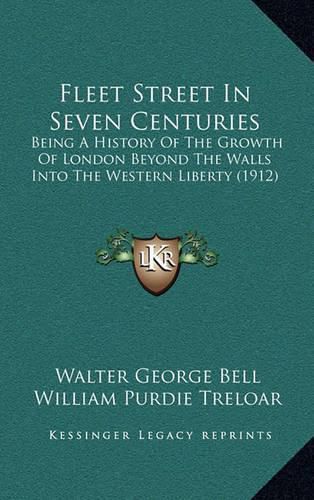Readings Newsletter
Become a Readings Member to make your shopping experience even easier.
Sign in or sign up for free!
You’re not far away from qualifying for FREE standard shipping within Australia
You’ve qualified for FREE standard shipping within Australia
The cart is loading…






Purchase of this book includes free trial access to www.million-books.com where you can read more than a million books for free. This is an OCR edition with typos. Excerpt from book: FLEET STREET IN SEVEN CENTURIES CHAPTER I WITHOUT THE WALLS OF LONDON Of all those noted thoroughfares within the walls and liberties of the famous old City of London, there is no one that can compete in its history and celebrity with Fleet Street. You may produce your Cheapside with its centuries of recollections, your Lombard Street with all its riches, your Cornhill with all its commerce, your Exchange with all its men of mark, even your famous old Bishopsgate with its princely remains of Crosby Hall; but there is not one among them that can equal that one street which takes its name from the old Fleet River, and extends from Ludgate Hill to Temple Bar.? T. C. Noble, Memorials of Temple Bar. An old grey wall cutting square across the hill-crest, a little stream flowing below between deep banks, filled high when the tide rose, and on the right the full flood of the Thames. Beyond, what had been a Roman city, left desolate and decayed, but not altogether abandoned; few, if any, of the buildings lofty enough to show above the guarding wall that had defied the centuries. In the broken foreground trees and herbage, and perhaps a hut or two?that is more doubtful? and near to the tributary stream a spring of pure water that welled to the surface, and trickled over its bank: the spring, or well, of St. Bridget the Virgin. These, and perhaps a worn path keeping parallel with the river, are all that can be recognised of London’s western Liberty when history opens. Lying below ground are relics associated with times long past, when St. Bridget’s spring ran clear and free. In excavations to the clay made in 1893 for an extension of Messrs. Ward and Lock’s premises by Bridewell Precinct, the navvies brought up a
coffin. It proved on examination to be not this, but an object …
$9.00 standard shipping within Australia
FREE standard shipping within Australia for orders over $100.00
Express & International shipping calculated at checkout
Purchase of this book includes free trial access to www.million-books.com where you can read more than a million books for free. This is an OCR edition with typos. Excerpt from book: FLEET STREET IN SEVEN CENTURIES CHAPTER I WITHOUT THE WALLS OF LONDON Of all those noted thoroughfares within the walls and liberties of the famous old City of London, there is no one that can compete in its history and celebrity with Fleet Street. You may produce your Cheapside with its centuries of recollections, your Lombard Street with all its riches, your Cornhill with all its commerce, your Exchange with all its men of mark, even your famous old Bishopsgate with its princely remains of Crosby Hall; but there is not one among them that can equal that one street which takes its name from the old Fleet River, and extends from Ludgate Hill to Temple Bar.? T. C. Noble, Memorials of Temple Bar. An old grey wall cutting square across the hill-crest, a little stream flowing below between deep banks, filled high when the tide rose, and on the right the full flood of the Thames. Beyond, what had been a Roman city, left desolate and decayed, but not altogether abandoned; few, if any, of the buildings lofty enough to show above the guarding wall that had defied the centuries. In the broken foreground trees and herbage, and perhaps a hut or two?that is more doubtful? and near to the tributary stream a spring of pure water that welled to the surface, and trickled over its bank: the spring, or well, of St. Bridget the Virgin. These, and perhaps a worn path keeping parallel with the river, are all that can be recognised of London’s western Liberty when history opens. Lying below ground are relics associated with times long past, when St. Bridget’s spring ran clear and free. In excavations to the clay made in 1893 for an extension of Messrs. Ward and Lock’s premises by Bridewell Precinct, the navvies brought up a
coffin. It proved on examination to be not this, but an object …